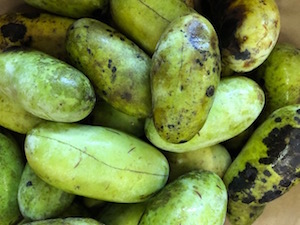The pawpaw is the largest edible fruit native to America. Read the very informative excerpts below from the California Rare Fruit Growers website–the bottom section on the Harvest will let you know what to expect from your paw paws.
Fruit: The pawpaw is the largest edible fruit native to America. Individual fruits weigh 5 to 16 ounces and are 3 to 6 inches in length. The larger sizes will appear plump, similar to the mango. The fruit usually has 10 to 14 seeds in two rows. The brownish to blackish seeds are shaped like lima beans, with a length of 1/2 to 1-1/2 inches. Pawpaw fruits often occur as clusters of up to nine individual fruits. The ripe fruit is soft and thin skinned.
Pollination: Poor pollination has always plagued the pawpaw in nature, and the problem has followed them into domestication. Pawpaw flowers are perfect, in that they have both male and female reproduction parts, but they are not self-pollinating. The flowers are also protogynaus, i.e., the female stigma matures and is no longer receptive when the male pollen is shed. In addition pawpaws are self-incompatible, requiring cross pollination from another unrelated pawpaw tree.
Bees show no interest in pawpaw flowers. The task of pollenization is left to unenthusiastic species of flies and beetles. A better solution for the home gardener is to hand pollinate, using a small, soft artist’s brush to transfer pollen to the stigma. Pollen is ripe for gathering when the ball of anthers is brownish in color, loose and friable. Pollen grains should appear as small beige-colored particles on the brush hairs. The stigma is receptive when the tips of the pistils are green, glossy and sticky, and the anther ball is firm and greenish to light yellow in color.
Harvest: Pawpaw fruit ripens during a four-week period between mid August and into October, depending on various factors. When ripe, it is soft and yields easily to a gentle squeeze, and has a pronounced perfumed fragrance. The skin of the green fruit usually lightens in color as it ripens and often develops blackish splotches which do not affect the flavor or edibility. The yellow flesh is custard like and highly nutritious. The best fruit has a complex, tropical flavor unlike any other temperate zone fruit. At present, the primary use of pawpaws is for fresh eating out of hand. The ripe fruit is very perishable with a shelf life of 2 or 3 days, but will keep up to 3 weeks if it is refrigerated at 40° – 45° F.

